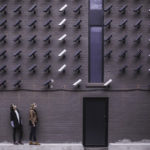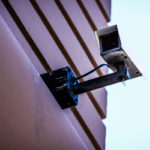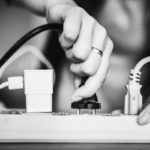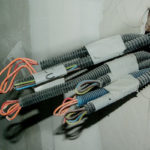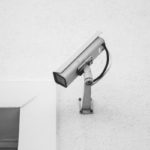Security Cameras: Do’s & Don’ts
Security cameras help to protect homes, businesses and various properties from burglaries, vandalism and more. Unfortunately, if they are not installed properly, they can do more harm than good. Before you invest and install a video surveillance system on your property, review these security camera do’s and don’ts.
DO:
- Place the camera where the roof or ceiling meets the wall.
This spot naturally shields the camera from the elements, and it can usually give you the widest angle of viewing. - Protect your cameras from weather, tampering, and vandalism.
Depending on your security cameras location, you may need to invest in a weatherproof casing to shield it from environmental conditions. Also, be sure to mount your cameras out of reach and with a protective plate to prevent criminals from tampering, disabling, or damaging your equipment. - Securely mount your surveillance cameras.
Be sure that your cameras don’t shake or wiggle if walking or other movement sends vibrations to the wall. This instability could distort the images that your camera is transmitting and could potentially cause damage to your cameras. You may need additional mounting brackets or equipment to ensure your cameras are securely mounted. - Place cameras in heavily-trafficked or shrub-heavy locations.
Because bushes provide cover for intruders, having a camera monitor these potential hiding spots will improve your surveillance. You also want to have eyes on areas with heavy traffic such as walkways or gates. - Set your base unit in your attic.
This is often the most convenient spot for all of your cameras’ wiring to originate from. It also minimizes the need to string cables up and down walls if they can be run on the insides of your eaves under your roofline.
DON’T:
- Just install a camera in an area that won’t be well-lit at night.
If you want surveillance around the clock, be sure that your security cameras have night vision or an infrared setting or lens that works in low light. For outdoor cameras, pair your cameras with exterior lighting with motions sensors if possible. - Attach a camera to a gutter.
This is always a bad idea. Despite being high up and out of reach, the camera is completely exposed to the weather and its weight will put undue stress on your guttering system. - Limit your cameras to just your front door.
You should be monitoring all areas where criminals can potentially gain access. Install surveillance cameras near your back doors, side entrances, and sliding glass entryways. You may want to consider a security camera at the top of your basement stairs in case someone gains access to your basement. - Place a camera right above a basement window.
This location leaves your camera within reach to be disabled or vandalized. Instead, mount a camera under the eaves or even a second-story roofline and direct the lens toward the basement window. - Assume wireless means “completely wireless.”
This is not always the case. Even if your surveillance system operates using wireless signals, each camera and your base unit will still need to be plugged into a power source.
Share your own tips with us and your peers on Facebook, Google+, Twitter, LinkedIn, and Pinterest.
Your security is our priority! If you need help choosing the best security cameras for you, feel free to browse our selection online at SecurityCamExpert.com or call 888-203-6294 to speak with a representative directly.
Mounting Outdoor Security Cameras
Outdoor security cameras aid in your first line of defense against criminals. The presence of outdoor security cameras can deter burglars from targeting you, or they can provide key evidence should an incident occur. Thus, the installation and mounting of your outdoor security cameras play an important role in the success of your surveillance system overall.
Height
Whether for home or business use, the height of your camera will determine what you can capture and the quality of the images. In a business setting, the camera should be able to view the surrounding area while still adequately capturing the faces of incoming customers and those around the front door. Thus, a security camera mounted at least 10 feet high should properly capture the faces and body types of individuals. For homes, you should mount a camera at least 3 feet above your front door and another at least 10-20 feet up to capture vehicles that enter and exit your driveway.
Location
If your cameras are not in the right location, they won’t be able to record crucial footage. You want your security cameras to cover all the main entrances to your business or home, as well as any potential weak spots (ex. first floor windows). For businesses, you also want to monitor your parking lot. Surveillance cameras in parking lots should be in a location that allows them a clear view of customers’ vehicles. And as mentioned, you should have a home security camera devoted to monitoring your driveway.
Visibility
Surveillance camera laws can vary from state-to-state, however, hidden cameras in private places, such as bathrooms, changing rooms, or locker rooms, are forbidden in all states. Since outdoor security cameras are not located in private places, they can be hidden to some extent. But again, the visibility of security cameras alone can play a role in discouraging potential burglars from striking. If you decide on hiding your outdoor cameras, be sure to place a sign on your property informing guests and visitors that they are under surveillance.
How have outdoor security cameras helped keep you safe? Want to share your own tips? Connect with us on Facebook, Google+, Twitter, LinkedIn, and Pinterest.
Browse our selection of outdoor and indoor security cameras, along with PTZ cameras, network IP cameras, surveillance system packages, and much more at SecurityCamExpert.com.
Troubleshooting Tips For IP Security Cameras
After investing your time and money into choosing the best security cameras to suit your needs, it can be frustrating to come across issues with them not working properly. When your security system is down, not only is it a nuisance, but it can leave your property vulnerable.
Before giving up on your security cameras and shopping for new ones, review these troubleshooting tips for common security camera issues.
- Connection & Power
Though it may seem like common sense, sometimes we overlook the obvious. If your security camera is not working, check all of the connections. Make sure that the camera is correctly connected to the power source as well as any other devices.For wireless security cameras – Check the Wi-Fi connection (if the wireless security camera is connected successfully via Wi-Fi). You can use a network cable to test the network connection. Ensure your router is working properly and, of course, check the power supply.For wired or PoE security cameras – Make sure video signal and power supply is well transmitted. For a PoE security camera, check the PoE injector or PoE switch is in order, compatible and working. If you have an NVR security system, double check that all the connections to the system are correct and secure.
- Cabling
A majority of connection issues center around cabling problems. For example, if the IR LEDs do not turn on at night in the dark, it is likely a cable problem and no images or video recordings will come out.To check this, use another cable to connect the camera to see if the problem is solved. For a PoE security camera, you use a Cat 6 or Cat 5 Ethernet cable.
- Settings
It is easy to forget about camera settings. You may find that your security camera doesn’t do 24/7 recording, no motion detection alerts, can’t connect to Wi-Fi, or can’t record video at night all because you did not set up the settings. Remember: Security cameras do have features, some of which have been enabled by default and some that need manual enabling on your end.There is usually computer software or an app for a mobile device that is in place so you can easily control and manage your system, such as adjusting the settings accordingly.
- Reboot
The “Golden Rule” in IT troubleshooting is to reboot the device. When you reboot a security camera, it flushes the cache, recalibrates the settings, and revises the connections. To reboot you camera, directly unplug the power supply, wait for a few seconds, and plug it in again. - IP Address
Each IP security camera needs to have a unique IP address so it can send and receive data via the Internet or a computer network. If there is another device using the same IP address with the camera, there will be a conflict and your security camera will not work. If you are experiencing issues, check the IP addresses to resolve any conflicts.There are two ways to check:
- On a computer that is connected to your cameras, go to the Windows search box and type “cmd” to open the DOS command prompt. You can type the command “arp -a” to see if there are any IP conflicts.
- You may type the command “ping cameraIPaddress -t” (ex. for IP address 192.168.0.999, type “ping 192.168.0.999 -t“). If you received results with “Unreachable” or “Timed Out” it means the IP security camera is not connecting to the network. You should change the camera’s IP address or assign a new one.
- Update Firmware & Software
Most manufacturers regularly release firmware updates to fix security camera issues and glitches, and also to add new features. Make it a habit to regularly check the brand’s official website to see if new firmware has been released for your camera and update accordingly. Remember to make sure the firmware you download is the correct version for your security camera.If you can’t connect to the security camera via software, it’s likely due to incompatibility of the software and firmware. If you are updating your firmware, be sure to check for updates for your software as well.Remember, it is best to use the software or app from the manufacturer since it is designed to work with all the features of your security camera without compatibility issues. While third-party software exists, it may or may not be fully compatible with your cameras.
- Reset To Factory Default
This is often one of the last ditch efforts to resolve an issue. Factory reset means all settings and configurations will be removed and will go back to the “factory default” settings (you will need to enable features and other configurations again).Some security cameras come with a reset button, while others may come with a pinhole as the reset function, requiring a needle to enable factory default.
- Manufacturer FAQs
Most of you problems or questions can be answered by checking the FAQ section of your manufacturer’s website. Search keywords about your problem and you should get related troubleshooting methods. - Tech Support
If the FAQ section did not help, you may want to reach out to the company from which you purchased your equipment. Most companies offer tech support and you can reach out via email or phone call. Remember to provide as much details as possible and a professional technician should be able to help you fix the problem or offer alternative options accordingly.
If you need help choosing the right security cameras for your property, as well as installation services, feel free to contact us! You may browse our selection online at SecurityCamExpert.com or call 888-203-6294 to schedule a site survey or get a free quote. You can also find us on Facebook, Google+, Twitter, LinkedIn, and Pinterest.
The Benefits Of Video Analytics
More and more surveillance camera systems are taking advantage of video analytics, which help to provide a better understanding of the areas being monitored. Whether they are added to your system via additional software or they are built-in to your security cameras, video analytics have advanced over time and deliver more practical and reliable performance.
Not only do video analytics improve overall security, but they can also provide valuable data for business intelligence. Here are some common and helpful video analytics functions and how they can benefit business.
- Facial Recognition
This function can identify individuals in real-time by cross referencing distinct characteristics against public and private databases and/or watch lists of known individuals. With that said, this function makes it easier to identify and locate wanted criminals if they are captured on smart cameras.
When it comes to casinos, for example, facial recognition can be used to detect cheaters. On the other hand, it can also be used to detect high rollers for VIP attention, or to detect high profile shoppers in a retail setting.
- Heat Mapping
Heat mapping measures and rates motion in a given image and uses color to portray the intensity of motion in that area. You might wonder how this data could help businesses, but there are numerous ways it does.
For example, retail stores can use heat mapping to better understand the flow of traffic. Knowing which way customers tend to travel when they enter the store (straight, left, right) can help business owners create a better floor plan. They can identify merchandising areas for optimal product placement which can then lead to increased sales. In addition, the data collected allows management to determine the high volume shopping days and times for more effective staffing and product placements.
- People Counting
This function is self explanatory, as it literally counts the number of people entering or exiting a specified area. This is especially useful for sports and entertainment venues as the data can help improve staffing for concession stands, ticketing areas, and entry/exit points. And since it is based on real-time data, security can better respond and allocate personnel when a large number of people quickly gather at an entrance. - Occupancy Estimation
Similar to people counting, occupancy estimation can determine on average how many people are present, even at different times of day. This data can benefit any type of venue or building. For example, event planners can optimize the use of space, improve staff planning, help determine business hours, and adjust lighting and temperature conditions accordingly. And in emergency situations, security can use this data to communicate with first responders to determine the best response. - Tripwire/Intrusion Detection
This acts as a virtual fence, which can detect when an object or person crosses the virtual line. When detected, security is alerted so they may assess the situation and address it right away. This can also reduce false alarms, and thus eliminate the added costs that go along with them. In warehousing and manufacturing environments, digital fencing can improve compliance by notifying personnel when people or materials cross designated work zone areas. - Motion Detection
Last but not least, motion detection has already proven extremely beneficial for security purposes. Nearly every security camera is equipped with motion detection, and with reason. This function allows you to designate an area of any shape or size, and when any motion is detected within this area, you will be alerted. Museums, for example, can benefit from this technology as it can be used to determine when people are getting too close to an exhibit, or when an object is picked up or moved.
Have you employed video analytics within your surveillance systems? Share your experiences with us on Facebook, Google+, Twitter, LinkedIn, and Pinterest.
For a grand selection of affordable, top quality security cameras and surveillance systems, please visit SecurityCamExpert.com. If you have any questions, would like to request a free quote, or want to schedule a site survey, please call us at 888-203-6294 and will be happy to help.
Surveillance Camera Features
Choosing the right video surveillance system can be tough. With various technologies to consider, as well as your own personal requirements, there’s a lot to consider. For your convenience, here are some common terms and technologies to help you choose the right video surveillance system for you.
Resolution
Because of our smart, HD televisions, we are all likely familiar with resolution as well as the units used to measure it (pixels). From its beginnings at 720 pixels to 1080p, we are now up to 4K and 5K resolution, with further advancements on the horizon.
The goal for resolution is to produce the clearest image for usability. This is defined by detection, recognition and identification and generally requires 80p around the face. Previously, pan, tilt, and zoom (PTZ) technology was employed to get a usable image. Now that camera resolution has greatly improved, less features and cameras are necessary to create high quality video surveillance.
Frame Rate
Another term you are likely familiar with is frame rate. The minimum requirement for the HDTV standard is 30 frames per second (fps). A higher frame rate is ideal, as it will produce a smooth, clearer video, however, it may not be practical. A higher frame rate also requires more bandwidth and storage space as these tend to be larger files. In this case, you should evaluate and prioritize your needs to determine the frame rate for you.
Networks & Storage
Security cameras are a small percentage of the overall cost of a surveillance system (the cost for cables and storage quickly accumulates). With that in mind, you should figure out what you intend to do with the footage so you can make the best decision for networks and storage. For example, ask yourself if you would like to store the footage for later review, actively monitor your feed, or would you like to do both.
Once you determine your goals and how long you need to retain footage (if at all), you can figure out how much space is necessary before your data gets overwritten. Depending on your system and needs, you may be able to refine these details per camera/location as necessary.
Video Compression
Since higher frame rates lead to larger files and more required storage, video compression technology works to counter that. As it advances, it promises to reduce bandwidth and storage to provide more affordable and convenient options for consumers. Currently, H.264 and H.265 are the standard, depending on the cameras you choose.
Light Sensitivity
As you may know, extreme light levels can interfere with a security camera’s ability to capture useful images. However, low light technologies have improved and can produce images in little to no light environments. For example, ‘lightfinder’ technology enables cameras to produce color video down to below one lux (one lux is a dark room, zero lux is an absence of light).
There’s also wide dynamic range, which allows cameras to capture usable images in varying lighting conditions. This feature adjusts and filters light to prevent washed out images, and is useful for hallways and doorways that can open into bright lights.
Software
While most systems come equipped with software (which should be updated and patched regularly and as necessary), you can find and install software applications that deliver specialized features and functions that you desire. Just remember that the higher the cost of the system means more features, which can translate into more training required to learn how to use it.
If you have any questions about security cameras or need help choosing surveillance systems and equipment, please feel free to contact us at 888-203-6294. You may also browse our stock online at SecurityCamExpert.com or connect with us on Facebook, Google+, Twitter, LinkedIn, and Pinterest.
Investing In Business Surveillance
Installing video surveillance for your business may be a significant investment, but it can also provide numerous benefits. Although concerns about privacy and costs may prevent businesses from seeing their true value, many will find that business surveillance not only protects the owners, but also the employees and customers alike. Overall, a business surveillance system can prove to be a valuable asset for businesses. Here are just some of the reasons why.
- Deter Thefts
While video surveillance may seem to be targeted toward outside threats, it can very well prevent insider thefts. Unfortunately, employee theft is a serious and common occurrence for many businesses. Security cameras can help to monitor employees, account for anything that goes missing, and deter employees from misconduct. - Increase Profits
Analyzing video can help businesses learn how to improve their strategy and increase productivity. Managers may supervise employees remotely, allowing them to determine which employees are helping or hurting the business overall (for example, too much conversation or inappropriate internet habits). Reviewing footage also helps businesses see which times of day are over or understaffed, enabling them to adjust shifts accordingly to maximize profits.In addition, businesses with video surveillance systems may be eligible for savings on insurance. The potential savings for having a security system installed may be significant and should be taken into account when determining whether or not to invest in surveillance.
- Workplace Incidents
Frivolous lawsuits are more common than we would like to admit. Luckily, video surveillance can help to protect your business in these instances. Surveillance footage may be used as evidence for legal purposes. And as mentioned previously, the presence of security cameras can deter harassment, violence, and other misconduct from employees, customers, or other outsiders.
Does your business have a surveillance system? What other advantages can business surveillance provide? Share your thoughts with us on Facebook, Google+, Twitter, LinkedIn, and Pinterest.
If you need help choosing the right security camera system for your business or home, please feel free to contact us at 888-203-6294 or visit SecurityCamExpert.com to browse our selection.
Choosing Security Cameras
The holidays are here and heightened home security may be on your mind. The potential for theft or vandalism is always present, regardless of your “safe” neighborhood. Protect your loved ones and your property with a security camera system tailored to your needs.
Getting Started
Before you start shopping around, it’s best to evaluate your security needs. Will you be using your security cameras indoors, outdoors, or both? Do you need a specific area covered, such as the front door, or would you prefer complete coverage of your property?
You also want to consider how you will use your cameras. IP security cameras enable remote access as the feed is broadcast over the Internet, and are a great option if you need to access your feed throughout the day while you’re away. You may also allow other people to view the feed (ex. roommates, family).
Once you have a good understanding of what you want and need, the next step is finding the security solution that fits. One thing that is a must for all security camera systems is quality night vision. You should be sure that video recordings are high quality enough that you can identify faces or license plates during the day or night.
Battery-Powered Cameras
Battery-powered security cameras can operate as standalone units, making them an ideal choice for those who do not need multiple cameras. Because they can be single-camera systems, they are usually more cost-effective than other surveillance options. They are also easy to install as they do not require running any wires or any physical modification to the location in which they are installed (with the exception of some models that require mounting screws to a base). This allows for convenience and flexibility, making it easy to relocate these cameras with minimal trouble.
These cameras are a smart option for apartments or rental properties, and most of these cameras provide special features such as motion detection alerts, automatic recording or motion, audio recording, or even two-way audio communication.
You should keep in mind that these security cameras will require a change of batteries from time to time. Also, these are often Wi-Fi IP cameras and require a stable internet connection for proper transmission and functioning. Without a stable network connection, video quality and access of your feed remotely via app may be compromised. In addition, you may need to factor a cloud storage fee in to your budget, depending on the camera you choose.
Hybrid Cameras
Hybrid security cameras are Wi-Fi cameras that operate via AC power cable, therefore, do not need to have batteries changed, and can be placed anywhere with a rare need to be accessed again.
Because they require AC power, they need to be placed relatively close to an outlet. And if you are looking to install a multi-camera system, this needs to be considered as you should have one available plug per camera and enough cable to reach the unit.
Much like the battery-powered units, these IP cameras transmit the video feed over the Wi-Fi network so they require a strong connection. The difference, however, is that some hybrid models use a local hard drive to store footage, allowing you to bypass cloud storage and fees.
In addition, these cameras may offer motion detection push notifications and recording, as well as audio recording and real-time two-way communication.
Wired Surveillance Cameras
Hard-wired cameras offer the greatest stability since both their power and video feed are transmitted via wires instead of battery or Wi-Fi. Because of this, these surveillance cameras are ideal for areas with high signal interference or unstable connectivity.
Some models provide Power over Ethernet (PoE), which means power and video are both transmitted through the same, single wire. This is helpful for those looking to install multi-camera systems for the entire home as it cuts down on numerous long distance cable runs. But in comparison to the battery-powered and hybrid solutions, these cameras require a more involved installation process thanks to the cables and wiring.
On the upside, wire transmission enables the file size and quality to be significantly higher (up to 4K). Because these are typically multi-camera surveillance systems, they are best suited for outdoor application or whole home or business solutions.
As far as storage, these systems require hard drives to compile and store the footage from various feeds. Storage requirements will depend on your individual needs. You must consider file size as well as how long you want to store your footage before it is overwritten.
If you need help determining how much storage you will need, or simply need help choosing the right surveillance system for you, please contact us 888-203-6294 or visit SecurityCamExpert.com. You may browse our selection of top quality security cameras and surveillance equipment, or inquire about our installation services, site surveys, or request a free quote! You may also connect with us on Facebook, Google+, Twitter, LinkedIn, and Pinterest.
What You Need To Know About Wired Security Cameras
So you’ve been debating between wired and wireless security cameras and you’ve finally made a decision to install wired security cameras. Here’s what you can expect:
Additional Equipment
When you purchase a wired security camera system, it will likely come with a DVR box, security cameras, and sometimes the necessary cables. However, the monitor, mouse, and keyboard (all of which are required for a wired security system) will need to be purchased separately.
Unless you have these items sitting around your home, it’s important to factor the cost of these additional items when you are shopping for a system. The only way you may be able to get around this is if you were to connect your cameras to a NAS that is already managed from your computer.
Cable Planning
Your security cameras need to be directly connected to the DVR box, therefore, you will need to be creative with how and where you will run cables across your home. Where you mount your cameras and the location of your DVR box will determine the cable routes. If you are doing this yourself, there are a few things to keep in mind.
Before beginning, make a plan and know the exact layout of your house. Also, find out if anything is in between your walls such as insulation or fire blocks that could potentially hinder cable runs. Map out your cable route before beginning the process, and invest in the proper tools to help you accomplish this task.
The Dirty Work
Again, if you will be installing your wired security camera yourself, be prepared to get your hands dirty. If you’re lucky, you may be able to simply run cables down through the floor, across the basement, and up through the floor on the other side of the house. However, you may be required to crawl through attics and crawlspaces. With that said, wear the appropriate attire and invest in good knee pads to protect yourself.
Network Connection
The benefit of having a wired security camera system is that you don’t need to connect it to the internet for it to work. The downside is that you cannot access it remotely when you’re away from home. While keeping your cameras off of the internet can be a safer bet, if you want to view your feeds remotely, you may want to consider connecting your cameras to your network.
If you need help choosing a wired security camera system and installing it, feel free to call 888-203-6294 or visit SecurityCamExpert.com. You can also connect with us on Facebook, Google+, Twitter, LinkedIn, and Pinterest.
Halloween Safety & Security Tips
Halloween is almost here, and this year it falls in the middle of the week. That makes your commute home a bit trickier as children may be roaming the streets already. And although it’s always important to watch for pedestrians, it is especially crucial on Halloween.
Aside from being safe on the road, it’s imperative to mind your children and your home. Here are some Halloween security tips to help you enjoy a safe and happy Halloween.
Trick-Or-Treating
Although going door to door collecting candy and treats from strangers is a Halloween tradition, it poses safety risks.
- Check All Treats Before Eating – All treats should be inspected by adults before children eat them. To be safe, toss anything that looks tampered with and anything that doesn’t come in a pre-wrapped package.
- Light Up The Night – Make sure your children are easily visible with flashlights, glow sticks, or even reflective tape. To make it easier, try using transparent bags for your children’s treats and toss a glow stick in there. That way, your kids have one less thing to carry and they are still easily visible.
- Consider An Alternative – If you would rather your children not go trick-or-treating, you may want to consider an alternative such as a haunted house or hayride. Or you can visit friends or family so that you need not worry about what they get in their bag.
- Host your own Halloween – Or you can simply host your own Halloween event at your home. This way, you are in the comfort of your own home and can keep an eye on your children and guests.
A Night On The Town
Leaving a porch light on when you leave for the night may not be the best idea. On Halloween, that is commonly known as a sign to come knocking for treats, and thus, people will soon realize that no one is home. Here are some ways you can protect your home while you are out.
Lights
Be sure to keep your home well lit. This will deter potential intruders or pranksters as it will appear as if someone is home and still awake. Outdoor lighting will eliminate shadows and hiding places.
Security System
Engage your security system if you have one. If you do not, now would be a great time to invest in a solid home security camera system.
- Settings – Review your camera settings and adjust accordingly. Keep your cameras focused on potential entryways (doors, windows), but you may also want a view of the streets and other areas around your home – pranksters may attack from any or all sides.
- Timers – Make use of light timers if you have them. Set timers to have specific rooms light up every now and then. For example, leave the living room light and television on but have the kitchen light turn on and off occasionally so it appears that someone is getting up for a snack.
- Arm Your Security System – Sometimes we may forget so it’s worth the reminder to set the alarm and lock your doors and windows before you leave.
Cell Phones
For most of us, cell phones act as our lifeline and have become essentials alongside our wallets and keys. If your child does not have a cell phone and will not be with you on Halloween, be sure you have the phone number for the supervising adult or someone who will be accompanying your child. You may even let your child borrow your phone for the night so that you have a way of keeping in contact.
- Charge It – Whether it’s your own phone or your child’s or both, be sure that all phones are fully charged before heading out. If your child is going out without you, you may want to check the signal reception where he/she may be.
- Check Your Security System – Your security system most likely enables remote viewing via an app or device, and should alert you of any suspicious activity. If alerts are not enabled, be sure to check in periodically.
Staying In
Although we may hate to imagine that persons with bad intentions may target us on Halloween, it is always a possibility. If you’d like, you can leave a bowl of candy on the porch with a sign that tells children how many they can take and that they are under surveillance. If you sit on the porch and hand out candy, keep your cell phone close and sit with a friend or family member (safety in numbers).
In addition to the aforementioned security tips, it is always in your best interest to use common sense on Halloween and every day. Make sure children stay away from strange neighborhoods and that they know they should not go inside someone’s home. If possible, travel with a group for maximum safety.
Do you have any other Halloween safety tips to share? Connect with us on Facebook, Google+, Twitter, LinkedIn, and Pinterest.
Invest in an affordable security camera system to protect your home. Visit SecurityCamExpert.com to browse our selection or call 888-203-6294 to discuss your options.
